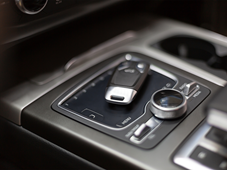HMI – Why Less is More
By Eric Grange | February 13, 2019

Modern cars come equipped with ever more technology, from adaptive cruise control, through navigation and collision detection systems, to sophisticated infotainment packages. As a consequence, designers must incorporate more controls into the interior of the car and, in doing so, must find the right balance between the aesthetic and ergonomic design of the human machine interface (HMI).
Current trends are to make more use of displays, whether on the dashboard or the instrumentation cluster, and a 10-inch display size is becoming the new standard, up from the 5 to 6 -inch norm of a few years ago. Displays have a number of advantages, including the integration of touch-sensitive capacitive switches, and the use of drop-down menus to “nest” multiple functions. The increased flexibility offered by displays and capacitive surfaces, combined with interior lighting options, affords the car designer a limitless range of possibilities when laying out the car interior.
However, a number of ergonomic considerations must be taken into account, particularly when balancing the use of displays with more traditional controls such as switches and buttons.
Safety is of fundamental importance in automotive design and, with the driver ultimately accountable for the behavior of the car, distractions must be kept to a minimum. Incorrectly deployed displays can create situations similar to the use of smartphones; time spent searching for a menu option on a wide screen is time not spent watching the road. Level 1 to 3 autonomous driving capabilities, such as lane warning and collision detection systems, can compensate for the increased reaction times caused by driver distraction, but even at level 3 the driver remains responsible for the vehicle and must be in control at all times.
Driver experience must also be taken into account by designers. The average age of the owner of a brand-new vehicle can be quite high, and older drivers may be used to the more conservative HMI layouts of previous generations of vehicle. For this type of driver, modern configurations can be intimidating rather than seductive and, as a result, some OEMs are moving in the opposite direction, re-introducing traditional switches and buttons in conjunction with touchscreen displays, to reassure the older driver.
At the other end of the scale is what is known as “aircraft cockpit” syndrome; premium vehicles are differentiated from budget versions by their level of functionality and, traditionally, the number of switches or buttons is directly linked to this level of functionality. For some drivers, therefore, there may be an element of disappointment to find that the interior of their new acquisition isn’t bristling with controls, having been replaced by screens and touch-sensitive surfaces.
Finally, regulations mandate that certain critical functions such as EPB, windscreen wipers, hazard lights and SOS call switches must be activated by mechanical controls, obliging the designer to deploy traditional, electro-mechanical technologies.
The above issues are being addressed by combining modern control systems with traditional techniques, leading to a diversified HMI in the modern automobile. This diversified configuration requires a specific type of switch, with certain important characteristics, including:
- “Passive haptics,” where touch-sensitive surfaces are coordinated with mechanical switches, enabling convergence of usability with design
- Short travel and high precision
- Tight tolerances dictated by the level of precision of plastic parts commonly used inside automotive controls
- Long lifetime
- Ability to work with new control technologies.
C&K’s large automotive switch portfolio offers the designer significant flexibility when integrating controls into modern car interiors, where aesthetics must be balanced against robustness and safety. Where specific requirements demand bespoke solutions, then our unmatched custom design capabilities make C&K the supply-chain partner of choice.
In automotive HMI design, less is often more and for C&K, with our 30 years of industry experience, customers continue to be supported with our advanced switch products for the innovative solutions they bring to market.

By Eric Grange, Automotive Segment Leader, C&K
